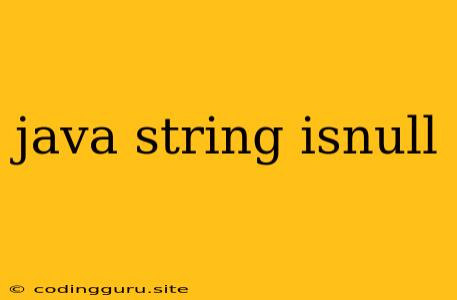Understanding Java isNull and Its Implications
In the realm of Java programming, handling strings effectively is paramount. Strings are fundamental data types used for representing text. One common challenge is dealing with the possibility of a string being null, which can lead to unexpected errors if not handled carefully. This article delves into the intricacies of Java's isNull concept and provides practical guidance on managing null string scenarios.
What Does isNull Mean in Java?
In simple terms, a null string in Java signifies that a string variable does not hold any reference to a valid string object. It essentially represents an empty or non-existent string. You can visualize this as a variable pointing to nothingness rather than a specific string value.
Why is Handling isNull Crucial?
The significance of handling null strings lies in preventing potential runtime errors. If you attempt to perform operations on a null string without proper checks, your program could crash or exhibit erratic behavior. For example, trying to call the length() method on a null string will result in a NullPointerException.
The isNull Concept in Action: A Code Example
public class StringHandling {
public static void main(String[] args) {
String myString = null;
if (myString == null) {
System.out.println("The string is null.");
} else {
System.out.println("The string is not null.");
System.out.println("Length of the string: " + myString.length());
}
}
}
In this code snippet, we first declare a string variable myString and assign it a null value. We then use an if statement to check if myString is null. If it is, we print a message indicating that the string is null. If it's not null, we proceed to print its length.
Best Practices for isNull Handling
Here are some essential practices for effectively managing null strings in Java:
-
Explicit Null Checks: Always check for null strings using the
==operator before attempting any operations. This is the most direct and reliable way to preventNullPointerExceptions. -
Optional Class: Java 8 introduced the
Optionalclass, a powerful tool for handling potential null values gracefully. By wrapping a string in anOptional, you can check its presence and perform operations safely. -
Default Values: When dealing with user input or data retrieved from external sources, it's wise to assign default values to strings to handle potential null cases. This prevents unexpected behavior and ensures your code remains resilient.
-
Defensive Programming: Employing defensive programming techniques, such as validating input data and handling exceptions, can greatly mitigate issues caused by null strings.
Beyond isNull
While isNull addresses the fundamental aspect of string emptiness, it's important to consider other scenarios:
- Empty String: An empty string (
"") is distinct from a null string. It represents a string with zero characters. - Whitespace: A string containing only whitespace characters (e.g., spaces, tabs, line breaks) may not be considered empty in certain situations. It's essential to determine your application's specific requirements regarding whitespace.
Conclusion
Understanding and handling null strings in Java is a critical aspect of robust code development. By adopting the best practices outlined above, you can effectively prevent runtime errors and create more resilient and predictable applications. Remember, the key is to be proactive in checking for null values and using appropriate techniques to manage them. Always strive to write code that is both robust and easy to understand.
